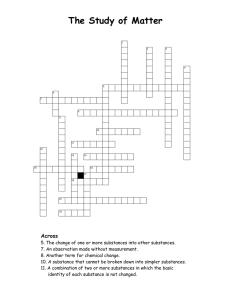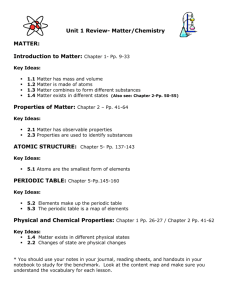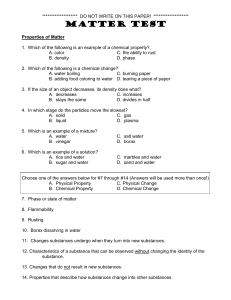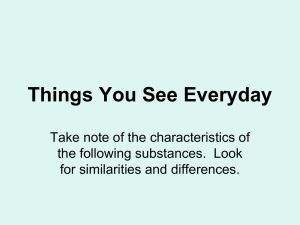Matter is….
advertisement
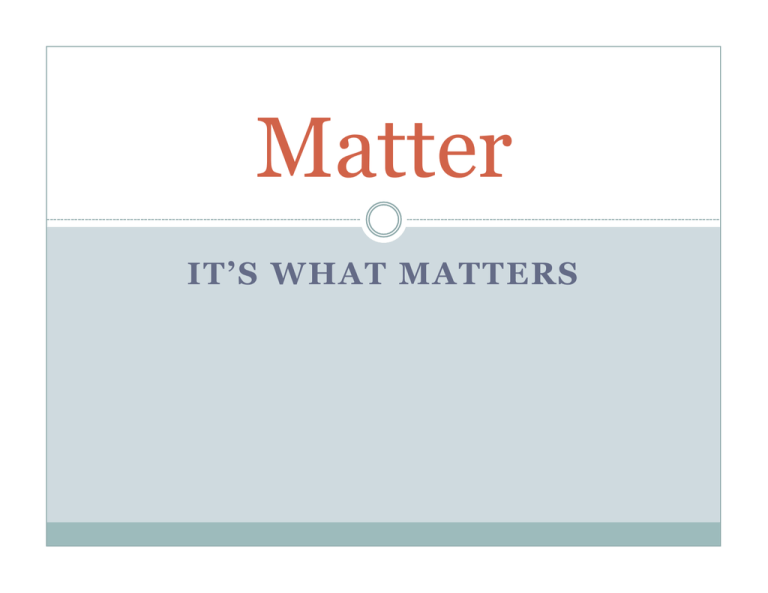
Matter IT’S WHAT MATTERS Matter is…. Anything that takes up space……… ……and…… has mass Matter Mass The amount of matter that an object possesses. Volume The amount of space occupied by matter. Building Blocks of Matter Atoms Smallest particle of an element that can exist can enter into a chemical reaction Building Blocks of Matter Elements Element: Building blocks of all substances, can not be broken down by chemical means to simpler substances. Building Blocks of Matter Compounds A distinct substance that contains two or more elements chemically combined in definite proportion by mass. Properties Extensive Properties a physical quantity whose value is proportional to the size of the system it describes. (ex. entropy, enthalpy, energy, mass, volume) Intensive Properties a physical quantity whose value does not depend on the amount of the substance for which it is measured. (ex. density, temperature, pressure, viscosity, specific heat capacity) Classification of Matter Mixture A MATERIAL CONTAINING TWO OR MORE SUBSTANCES AND CAN BE EITHER HETEROGENEOUS OR HOMOGENEOUS. BOTH SUBSTANCES ARE STILL PRESENT. Mixtures are either… Homogeneous Heterogeneous Matter that is Matter consisting of uniform in appearance has the same properties throughout. two or more physically distinct phases. Mixture Heterogeneous Homogeneous Ways to Separate Mixtures Filtration Distillation Chromatography Substances A PARTICULAR KIND OF MATTER WITH A DEFINITE, FIXED COMPOSITION. Substances Elements Compounds Elements and the Periodic Table Period The horizontal groupings (rows) of elements in the periodic table. Group / Family Vertical groups of element in the periodic table with similar outer-orbital electron structure. Types of Elements Types of Elements Metals Are solids at room temperature, have high luster, are good conductors of heat and electricity, are malleable, ductile, have high melting points and high density. Types of Elements Nonmetals Are not lustrous, have low melting points and densities, Are poor conductors of heat and electricity Types of Elements Metalloids Have properties that are intermediate between metals and nonmetals Types of Elements Noble Gases A family of elements in the periodic table that contain a particularly stable electron structure. Physical and Chemical Properties IT’S ALL IN HOW YOU LOOK AT IT States of Matter Physical and Chemical Properties http://www.youtube.com/watch?v=-Ypwtjp0FSE Physical change A change in form Such as: Size Shape Physical state Chemical properties The ability of a substance to form new substances either by reaction with other substances or by decomposition. Chemical Change A change producing products that differ in composition from the original substance. Evidence for Chemical Change Bubbles (production of a gas) Water vapor Light produced Precipitation Heat being given off or heat absorbed Color change (maybe) Types of Chemical Reactions Combustion Burning Synthesis Creating Decomposition Breaking down Single replacement Swapping a “partner” Double replacement Swapping “partners” Image Sources http://www.daviddarling.info/encyclopedia/N/ noble_gas.html http://www.periodictable.com/Elements/Metalloids/ index.html http://www.ndt-ed.org/EducationResources/ CommunityCollege/Materials/Introduction/metals.htm http://www.ethanolator.com/vacuumdistillation.htm http://www.gcsescience.com/e5-filter-paper.htm http://www.csmate.colostate.edu/cltw/cohortpages/ viney_off/atomhistory.html
